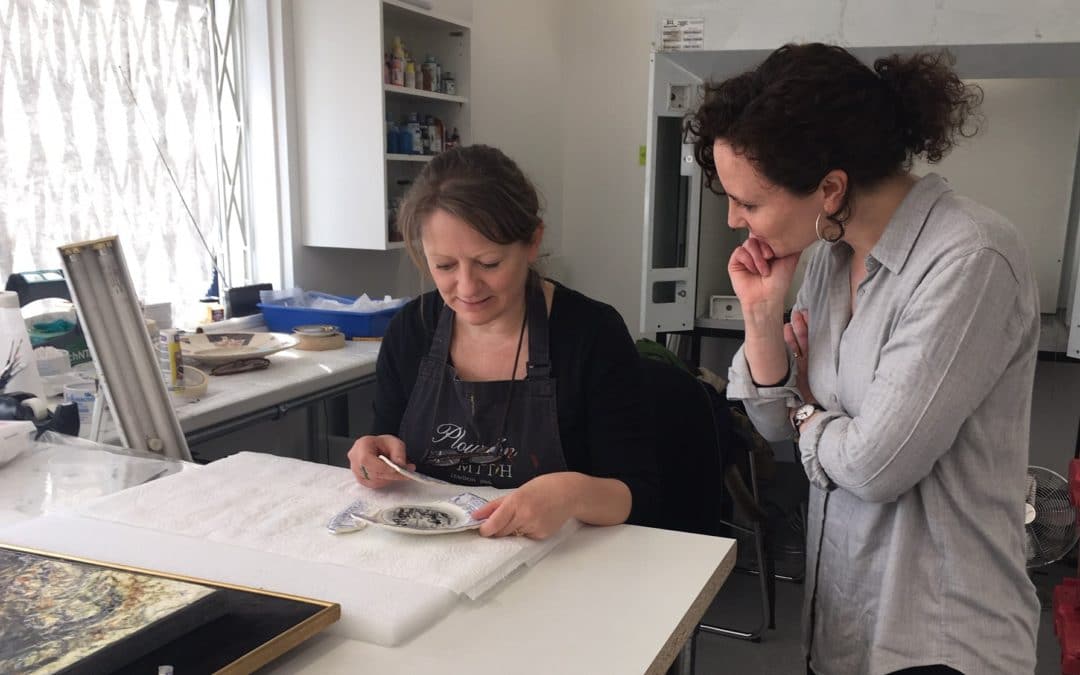Emily discussing a treatment with Plowden & Smith Head of Ceramic Conservation, Madeleine Graham
British Antique Dealers’ Association (BADA) intern Phoebe Brereton spoke with Emily Beavan, Senior Conservation Manager at Plowden & Smith, to gain her insights into the world of restoration.*
Q: Tell me more about your role at Plowden & Smith
A: I’m trained as a stone conservator, so I did a fine art degree and specialised in conservation, then I got a job at Plowden & Smith as a stone conservator. As a conservation manager I supervise all of the studios, manage all the conservators, make sure that they have exactly what they need in terms of equipment, and support in terms of technical questions.
Q: How do most people get into the field of restoration?
A: A fine art degree or a sculpture degree is a good start. I know a few members of our staff have done that. Then they think “where do you go from there? I want a job where I can use my hands, I’m interested in history, I’m interested in art.” Combining the two, you find yourself interested in conservation, whether it’s paintings, ceramics or metal.
Q: So, everybody works in an area they specialise in technically?
A: Yes, and then you may need to go on a specialist course. For example, there are paper conservators who do a paper conservation course and learn about photographs, prints, other works on paper like maps or family trees. It’s quite bespoke, each area is definitely very specialised.
Q: Within each specialised area do people have another niche that is their own thing?
A: Yes exactly. In the decorative arts department, we have three decorative arts conservators, and while they all have a very good knowledge of conservation, they have different areas of specialisms. One of them focuses on modern materials, so she can work with rubber, plastic, more contemporary art. Another is a specialist in gilding, so she can gild frames in super speedy time. And then another person is focussed on laquerwork and verre eglomise, so traditional Japanese techniques. They develop that naturally through their own interests, through work practice but also through courses, because we’re really keen to train people and invest in people.
Q: What are your thoughts on restoration through the ages? Surely, it’s something that’s always been required: is there a lineage of restorers who pass on their knowledge? Or is it more a case of individuals who find themselves in the field through their own interest in the period?
A: It’s really interesting, isn’t it? As you’re talking I’m thinking about someone who’s been working for us for forty years. He’s in his seventies now, and he has all that technical experience. He’s very old school: he’s learnt it as a silversmith and as a jeweller, so obviously all of that restoration knowledge was passed over to him.And that is where his flair is, the manipulation of metal, the manipulation of techniques. And in the same department we have someone who went to UCL who’s doing her PhD in metals conservation. She’s got all of the theory and the contemporary conservation ethics, the ideology – she understands all the psychology behind that. And he teaches her, so they’re showing each other. And that’s why we thrive on that fresh information. Old people can teach new people and vice versa.
Q: It’s really a development of the discipline, with people approaching it from both those angles.
A: Yes, and the younger person is learning all of those hand skills and becoming a really well-rounded kind of conservator.
Q: So there’s a difference between restoration and conservation? And you practice both, according to what your client wants?
A: Exactly, and according to what we ethically think is acceptable. It’s got to be reversible, so any treatment that we put in must be able to come back out again, not to damage the object. Also, restoration is a much more old-school way of doing it. It’s sort of making it as good as new, whereas now we have to accept that there’s some damage and that maybe it’s part of the history of the object. Conservation is a bit more subtle and a bit more sensitive.
* First published on the British Antique Dealers’ Association (BADA) website (https://www.bada.org/news/interview-emily-beavan-plowden-smith) and reproduced with kind permission of BADA.
To find out more about Plowden & Smith’s restoration and conservation services please contact hannah.sanderson@plowden-smith.com

